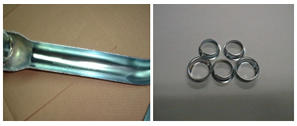Chemical conversion treatment in plating is to generate stable compounds on plated surfaces by using chemical and electrochemical techniques for the purpose of making plating films more functional. Colorability, corrosion resistance, film bondability, etc., are improved by chromium chemical conversion treatment or phosphatization after zinc plating.
| Type of plating | Features (characteristic value) | Characteristic value |
|---|---|---|
| Chromium chemical conversion treatment (Trivalent and hexavalent chromium chemical conversion treatment) |
- Improving corrosion-resistance performance of zinc plating - Giving corrosion resistance and coloring for product identification Bright chromate Colored chromate Black chromate Green chromate - Due to the restriction of use of hexavalent chromium according to an RoHS Directive, treatment has shifted from hexavalent chromium (chromate) chemical conversion to trivalent chromium chemical conversion. In the trivalent chromium treatment, bright, colored, and black films have been obtained, but green chromium conversion films have not been commercialized yet at present. |
- Hexavalent chromium conversion (chromate) films are sensitive to heat (70°C or less), but trivalent chromium conversion films are extremely strong against heat (100 – 150°C). |
| Phosphatization | Bondability between high-polymer materials, such as coating films and rubber, and metal surfaces is improved. | |
| Black oxide treatment | Various metals are blackened. | |
| Other chromium-free chemical conversion treatment | Molybdic acid-based films, tungstic acid-based films, tannic acid-based films, zirconium-based films, vanadic acid-based films, cerium-based films, silane coupling-based films, etc. | |

Trivalent chromium chemical conversion treatment of zinc plating